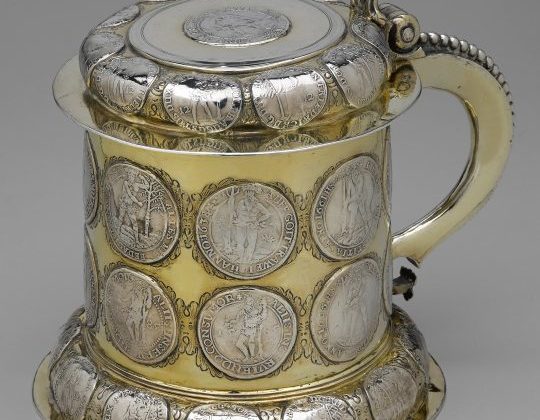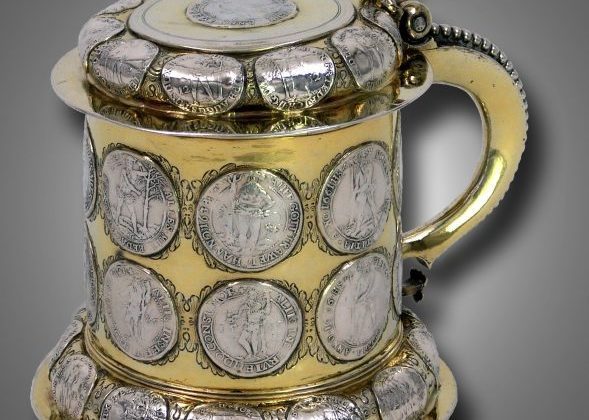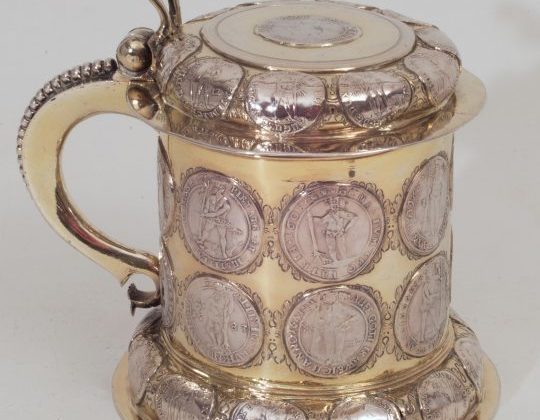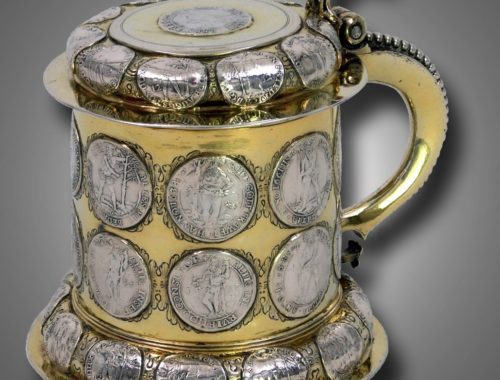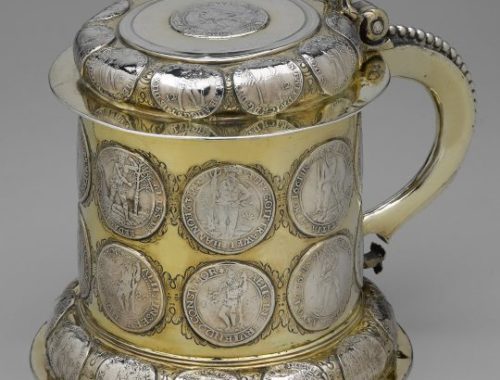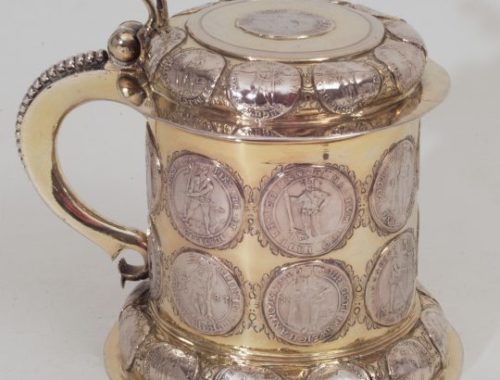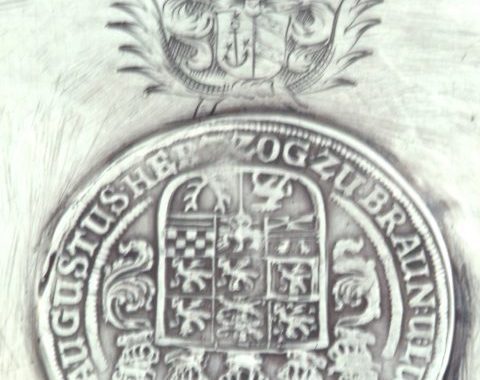Detailed Information
This parcel gilt coin tankard is raised on a bright, round, vaulted and profiled rimmed foot. The cover is round and has a strong profile which is hinged, along with a large thumb rest in a the form of a V. The side cast handle is ear-shaped and is decorated with a delicate pearl-band. The decoration of the foot, body and cover is made of insetted coins, whilst the sixteen German talers (coin) sit between embossed and engraved foliage and grotesque faces. On the cover is adorned with a line of ten coins which is also seen on the foot accompanied by a line of fourteen coins. Whilst the walls are decorated with two lines of eight coins each.
The many talers (coin) are imprinted with a plethora of lines of the House of Brunswick-Lüneburg. These coins are also emmbossed with the so-called “Wild Men”. Wild Men were a mythical creature, which supposedly represent half-human, half-woodmen, along with being a symbol for the House of Welf and for the Harz region in Northern Germany.
The Wild Man
The wild man was a literary and artistic invention of the medieval imagination, which flourished, particularly, in Germanic lands like the Harz region, and with time spread throughout Europe. Universally the wild man is associated with a large club or uprooted tree, which is held in his hand. Depictions of the wild man have appeared in every medium of art work (manuscript illuminations, metalwork, painting, etc.) since the fourteenth century. With the gradual collapse of the feudal system, and thereby the development of urbanity and the ascent of a middle class since the fifteenth century, the Wild Man was no longer perceived as a negative myth. But rather noticed as a harmless creature, with limited knowledge – including the lack of knowledge in the existence of God – and was immune to the ills of civilisation.
The Wild Man and the House of Welf
In 1539the Wild Man appeared, for the first time, on the imprinted coins of Henry, Duke of Brunswick-Lüneburg and Prince of Wolfenbüttel, know as the Younger (1489-1568). In 1529, he founded a mountain town named Wildemann followed by the establishment of the silver mine Wildermann, the mining tunnel Wilder Mann and later the mine Wilde Frau (= Wild Woman). Until the end of the eighteenth century, the Wild Man was a popular motif for coins of the House of Welf.
The initial use of the wild man on the coinage of Henry the Younger is responsible for the negative association with of the Wild Man. However, the polemical intention of the coinage of the wild man was due to Henry being the only catholic power in Northern Germany surrounded by (hostile) Protestants. He wanted the one hand on the wild man to express the source of his wealth (the silver mining in the Harz Mountains) and with the other he wanted to present a parallel representation of him as an uncorrupted man.
On the coins, the Wild Man, is clothed in shaggy covering of vegetation and in one of his hands bears the traditional iconography of a tree-trunk.The representation of the new wild man rests upon the inspiration taken from its background of local legend and folk-law, whether from the forest, or mining or from both. On the edge of the bigger coins, there are inscriptions. Among which some refer to the saying “Alles mit Bedacht” (= everything with caution), something that could have functioned as a reminder for those who drink beer from this tankard.
Maker: Mathes Francke, became a master around 1685. In 1701, he moved from Glogau to Beuthen and worked there as a Goldsmith (s. Hintze 1979: 110-1).
Literature
Hintze, Erwin, Schlesische Goldschmiede, Osnabrück: Zeller, 1979
Hintze, Erwin & Masner, Karl (Hrsg.), Goldschmiedearbeiten Schlesiens. Eine Auswahl von Goldschmiedearbeiten schlesischer Herkunft oder aus schlesischem Besitze, Breslau: [Schlesischer Altertumsverein], 1911
Husband, Timothy & Gilmore-House, Gloria (with assistance), The Wild Man: Medieval Myth and Symbolism, New York: The Metropolitan Museum of Art, 1980


